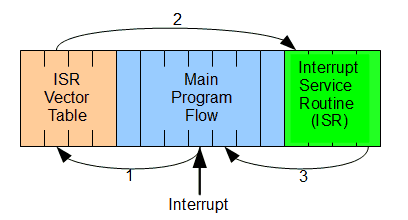This tutorial is based on Atmega328 microcontroller, which is popular in Arduino boards. So you’ll be able to test all code examples on Arduino as it can serve as general purpose AVR test board with no problem.
Understanding Interrupts
Probably you won’t be able to find a microcontroller without interrupt capability. These are essential attributes of any modern microcontroller or processor. They may seem confusing and tricky at first glance, but during the time, you will find out that regular MCU operation is impossible without interrupts.
Interrupts can be compared to real-life events. Look around – all your activities are full of them. For instance, you are reading this tutorial and find it interesting, so you are all in it. But suddenly, your cell phone rings. What do you do? You remember the last stroke you’ve read and answered the phone. One phone conversation is over; you return to your reading as if nothing happened. Well, this is only one example of interrupt to give some visual clue what interrupts are.
Interrupts in microcontrollers are very similar to this example, so there should be no problem to understand them. Let’s get more specific and closer to hardware.
Microcontrollers usually have multiple interrupt sources available. For instance, Atmega328 has 26 of them. So program flow can be interrupted by various events like external pin going low, timer overflow, or ADC conversion complete. If set correctly, these events will take over program flow once they occur and give back resources once they’ve been serviced. As we mentioned, a microcontroller can have multiple interrupt sources. AVR is equipped only with hardware interrupts. Other microcontrollers may have software interrupts as well. Hardware interrupts mean that they can only be generated by hardware events like pin change or other. If you look into AVR datasheet you will always find a table of interrupt vectors like this:

This table is programmed into microcontroller memory along with your program as it is a reference table containing the address of interrupt service routines – a special functions that will be called once interrupt occurs.
As you can see in the table, there is a column “Program Address” these are locations in flash where an interrupt service routine is located in program memory. For instance, at the very beginning of flash (0x0000), there is a reset address stored. This means when MCU is powered program will look at this location and jumps to place where tour main() program starts. When programming in C – interrupt table is created automatically during compilation, while ASM programmers have to set this table by themselves. Without going into details it is worth mention that interrupts vectors can be stored in the boot section depending on fuse settings – so bootloader could use benefits of interrupts. But leave this for some time later.
In the image, you can see a simple interrupt handling sequence. Let’s say our program does some tasks in the Main program flow. When interrupt signal occurs at any given moment of program flow, it stops at the current location, remembers following operation address, and then loads the program counter with ISR address (1) stored in ISR vector table. From this moment interrupt handling function is performed (2). Once it’s complete program counter is loaded with next interrupted program operation (3). So the main program doesn’t know that interrupt has occurred and continues usually. This is a very simplified illustration of an interrupt as we didn’t mention preserving of register values during interrupt and so on. But let’s leave this when we get to the code examples.


